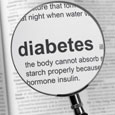by Catherine
Winters
Seven surprising factors that may boost your odds of developing
diabetes—and how to protect yourself.
By now, we should all be able to recite the things that raise a person’s risk
for Type 2 diabetes—increasing awareness, after all, is the point of November’s
American Diabetes Month. It’s well-established that getting older, being
overweight, not exercising and having high blood pressure, high triglycerides
and low levels of HDL (the good cholesterol) raise your odds of developing the
serious-yet-preventable disease predicted to affect more than 53 million
Americans by 2025. But new research is uncovering some surprising behaviors and
physical conditions that may also boost your chances of developing Type 2, which
in turn can cause heart and kidney disease. Add these factors to the list.
Eating white rice. In a review of four studies, Harvard
researchers found an 11 percent jump in Type 2 risk for each serving (about one
cup) of white rice consumed. While more research is needed to prove the
connection, switching to whole grains like brown rice is a good move, anyway.
Whole grains contain fiber and magnesium, which may protect you from diabetes.
They also help keep your weight in check: “People who eat whole grains feel
fuller on fewer calories,” says Dr. Vivian Fonseca of the American Diabetes
Association.
Being big around the middle. In a British study, obese men
with waist circumferences of 40 inches or larger were 22 times more likely to
develop diabetes than normal-weight men whose waists were narrower than 37
inches. Waist measurements of 34 inches or larger boosted obese women’s risk by
nearly 32 times compared with middles measuring less than 31 inches. “People who
carry fat around the waist are more likely to have fat in the liver and
pancreas, which interferes with insulin production,” Fonseca explains.
Sitting too much. In a study of 500 men and women,
researchers discovered that women who sat the longest (up to 7 hours a day)
fared the worst on tests measuring C-reactive protein, a marker for
inflammation, as well as insulin resistance and obesity. Why the bigger toll on
women? Women may snack more when they sit; and men may engage in more vigorous
activity when they do get off their duffs. Walking just 30 minutes a day, five
days a week and losing about five percent of your body weight, if you’re
overweight, is your best defense.
Not sleeping enough. Too little sleep and an out-of-whack
circadian rhythm (the body’s natural sleep-wake cycle) caused blood sugar to
stay elevated longer, spiking to prediabetic levels in some sleep-deprived
subjects, in research at Brigham and Women’s Hospital in Boston. In addition,
metabolic rates dropped by eight percent, a change that could lead to nearly a
13-pound weight gain over the course of a year. The good news: Once people
resumed a normal sleep-wake schedule, blood sugar levels and metabolic rate
returned to baseline or near-baseline levels.
Working the night shift. Harvard researchers found that women who
worked three or more nights per month—in addition to day and evening shifts—for
three to nine years saw their diabetes risk jump by 20 percent. Shift workers
who logged 10 to 19 years saw a 40 percent risk increase; those working nights
for 20 or more years upped their risk by 58 percent. The study authors speculate
that weight gain may be the culprit, and advise that women working the night
shift be extra cautious about eating healthfully, exercising and establishing
healthy sleep habits.
Running low on D. In a Tufts University study, people with the highest
levels of vitamin D had nearly half the risk of developing metabolic syndrome—a
cluster of symptoms that raises the risk for Type 2 diabetes and heart
disease—compared to people with the lowest D levels. There’s no proof, though,
that vitamin D can prevent diabetes. Still, the Institute of Medicine suggests
taking at least 600 IUs of vitamin D daily (800 IUs if you’re over age 70) on
top of whatever you get from sun exposure (no more than 10 to 15 minutes a day)
and diet (D-fortified milk, salmon and swordfish are the best sources).
Having psoriasis. Danish researchers reported that Type 2 risk is
nearly twice as high for people with severe psoriasis, an autoimmune skin
disease, than it is for those with milder cases. A possible explanation: Both
Type 2 and psoriasis are associated with chronic inflammation. The take-home
message: While more research is needed, psoriasis sufferers should work to lower
their diabetes risk through lifestyle changes and get screened for insulin
resistance.
 Dr. Weil routinely recommends the following three supplements for people
diagnosed with diabetes. They may help regulate glucose levels and promote heart
health, both of which may be especially beneficial for diabetics. Talk with your
physician about the best way to integrate these into your overall diabetes
treatment program.
Dr. Weil routinely recommends the following three supplements for people
diagnosed with diabetes. They may help regulate glucose levels and promote heart
health, both of which may be especially beneficial for diabetics. Talk with your
physician about the best way to integrate these into your overall diabetes
treatment program. Managing diabetes mindfully means more than just monitoring blood sugar
levels. It also means making prudent dietary choices to lower the risk of common
health conditions associated with diabetes, such as heart disease, high blood
pressure and stroke. Work with your physician and a dietician to create a meal
plan that best suits your needs. Research has shown that several nutritional
elements may be helpful in managing diabetes-related issues:
Managing diabetes mindfully means more than just monitoring blood sugar
levels. It also means making prudent dietary choices to lower the risk of common
health conditions associated with diabetes, such as heart disease, high blood
pressure and stroke. Work with your physician and a dietician to create a meal
plan that best suits your needs. Research has shown that several nutritional
elements may be helpful in managing diabetes-related issues:
No comments:
Post a Comment